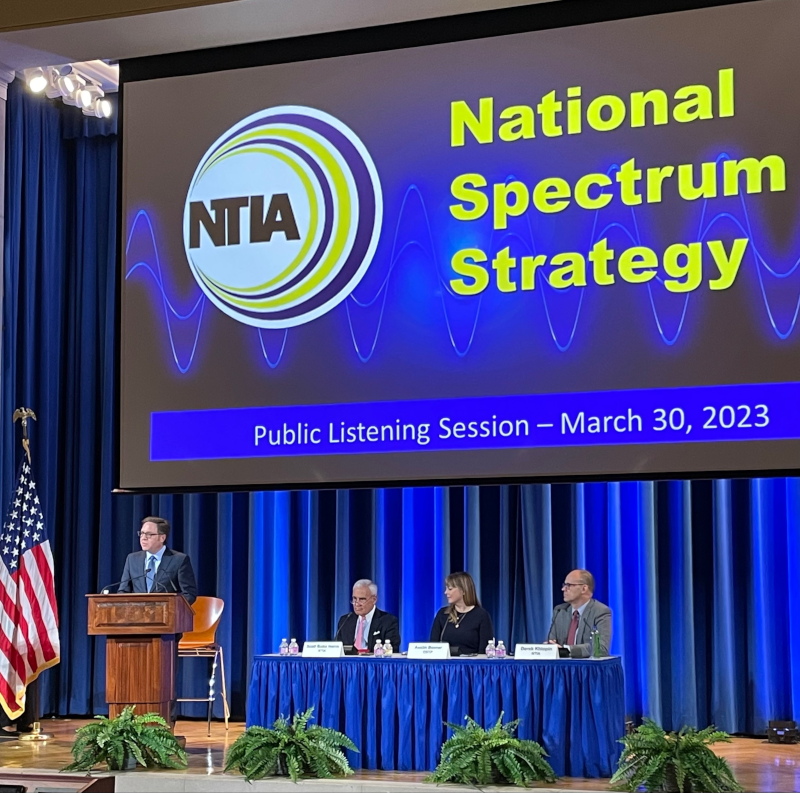NTIA Blog
National Spectrum Strategy Input Showcases Diversity and Importance of Spectrum Uses
Wireless connectivity empowers nearly every aspect of modern life, and reliable access to spectrum resources is essential. So, it’s perhaps no surprise that NTIA has received an immense amount of feedback on the development of a National Spectrum Strategy since announcing the start of this effort on March 15. 
Most recently, the period for providing responses to NTIA’s Request for Comments (RFC) closed April 17. NTIA received 131 written comments from stakeholders who provided in-depth information in response to questions about the nation’s spectrum needs, how best to engage in long-term spectrum planning, and technology innovations that can help better manage the nation’s spectrum resources. The comments are now accessible both on NTIA’s website and on Regulations.gov.
How Public Comments Helped Shape NTIA’s Innovation Fund
On Wednesday, the Biden-Harris Administration announced the formal launch of the $1.5 billion Innovation Fund, an initiative designed to support the development of open and interoperable 5G and future generation technologies. Funded by the CHIPS and Science Act of 2022, this historic investment aims to drive wireless innovation, strengthen supply chain resilience, and unlock opportunities for new and emerging companies to compete in the global telecommunications market. With the publication of our first Notice of Funding Opportunity (NOFO), NTIA is moving one step closer to achieving a diverse, sustainable, and competitive wireless supply chain.
Honoring America’s 9-1-1 Professionals
NTIA is seeking a new Member for the FirstNet Authority Board
The National Telecommunications and Information Administration (NTIA) issued a Federal Register Notice to seek expressions of interest from individuals who would like to serve on the Board of the First Responder Network Authority (FirstNet Authority Board or Board). Prospective candidates must have expertise or experience in at least one of the following areas: public safety, network, technical, and financial. The FirstNet Authority Board is responsible for providing overall policy direction and oversight of FirstNet to ensure that the nationwide network continuously meets the needs of public safety.
The 15-member FirstNet Authority Board includes 12 non-permanent members, the Secretary of Homeland Security, Attorney General of the United States, and Director of the Office of Management and Budget. One of the 12 non-permanent members to the FirstNet Authority Board resigned prior to the end of his term. The Secretary of Commerce will appoint an individual to complete that Board member’s term through September 2024.
High-speed Internet makes a new house a home
Strategies for Including Women in Internet for All Construction Jobs
Breaking barriers in fiber fieldwork
A hotspot puts graduation in reach
Making Internet for All Right Here in America
FEBRUARY 9, 2023
The Internet for All initiative is a critical component of the Biden-Harris Administration’s overall strategy to build a more dynamic economy. It will enable American workers and businesses to compete on the global stage and generate new economic opportunities in overlooked communities throughout the country. Internet for All will create as many as 150,000 jobs nationwide – but to maximize the economic potential of this initiative, manufacturers and Internet service providers will need to build right here in America.
As President Biden said in his State of the Union Address this week, “[w]e’re making sure that every community has access to affordable, high-speed Internet...And when we do these projects, we’re going to Buy American.” The president made clear that while Buy America has been the law of the land since 1933, too many administrations have found ways to skirt its requirements.
We will not.
The iron and steel, manufactured products, and construction materials needed to deliver affordable, reliable, high-speed Internet service to millions of Americans is an opportunity to create jobs and opportunities right here in America. That’s why NTIA believes that if it can be Made in America, it should be made in America – and it’s why we’ll strictly enforce ‘Build America, Buy America’ (BABA) requirements outlined in the Bipartisan Infrastructure Law and the Internet for All Notices of Funding Opportunity (NOFOs).
A $300 million down payment on Internet For All
NTIA ended 2022 by awarding $304 million in funding to every state, along with Washington, D.C., and Puerto Rico, for planning how to best deploy networks to connect everyone in America to affordable, reliable, high-speed Internet service.
States are set to receive a historic influx of funding to expand high-speed Internet service thanks to the Bipartisan Infrastructure Law. The planning grants awarded in 2022 are down payments so the states can prepare to use the coming billions in broadband funding effectively.
Each state has different needs and unique challenges in bridging the digital divide, and our planning grants recognize the importance of flexibility. Still, there are broad trends driving the ways states are putting this money to use.
